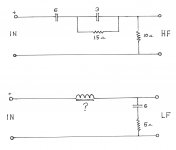I’m hoping that someone experienced in crossover design may he able to help me understand the “workings” of an Altec Lansing network that was used in a 1970s system. The speakers are 890C “Boleros”, a two way ‘bookshelf” system featuring a passive radiator and a small horn. A diagram is attached below for the seemingly simple first order network. I am: 1/ Building a new pair of enclosures, following the dimensions of the originals, since I have a number of extra drivers, but no extra crossovers. 2/ eventually planning to bi-amp my system and I’m trying to understand the existing network, as a starting point.
The high frequency speaker is a “Foster” horn (still available today) with the following specs: SPL:100db 1W/1M, Frequency response: 1KHz to 18KHz. Fs: 965Hz Recommended crossover: 3.5 KHz. Le: 0.10mh. Z: 8ohms, Re: 7.05 ohms.
The Altec “advertised” crossover frequency is 2K, which doesn’t seem likely, but frankly, I don’t understand the 15 ohm resistor paralled with the 3 mfd cap. Can anyone explain what the effect of this combination may be? The 10 ohm “pad” across the horn is actually part of a three way switch-selectable attenuator that I didn’t bother to diagram. The 10ohms can be switched to 30 ohms for a 3 db boost, or 6 ohms for a 3 db cut.
The low frequency driver is a 406-8C which is a 10 inch version of a 515B. It uses the same motor and magnet assembly, but a slightly different shaped cone for improved mid-range/ HF performance. Altec never released specs for this exact speaker, but it’s 8 ohms, Re: 6.7 ohms, and an Le of .001 Hy. (the entire speaker series using this VC was rated exactly the same). SPL: approx 96db 1W/1M. I’m stumped by the values of the Zobel, which seem to be pretty far from calculated values. Anyone have any ideas why this may be? I do not know the value of the iron core choke, but I’m guessing that it’s less than would be expected for a 2000Hz crossover. I may try to measure it.
They are great sounding speakers, and I assume that Altec knew what they were doing, providing these network values for a reason.
The high frequency speaker is a “Foster” horn (still available today) with the following specs: SPL:100db 1W/1M, Frequency response: 1KHz to 18KHz. Fs: 965Hz Recommended crossover: 3.5 KHz. Le: 0.10mh. Z: 8ohms, Re: 7.05 ohms.
The Altec “advertised” crossover frequency is 2K, which doesn’t seem likely, but frankly, I don’t understand the 15 ohm resistor paralled with the 3 mfd cap. Can anyone explain what the effect of this combination may be? The 10 ohm “pad” across the horn is actually part of a three way switch-selectable attenuator that I didn’t bother to diagram. The 10ohms can be switched to 30 ohms for a 3 db boost, or 6 ohms for a 3 db cut.
The low frequency driver is a 406-8C which is a 10 inch version of a 515B. It uses the same motor and magnet assembly, but a slightly different shaped cone for improved mid-range/ HF performance. Altec never released specs for this exact speaker, but it’s 8 ohms, Re: 6.7 ohms, and an Le of .001 Hy. (the entire speaker series using this VC was rated exactly the same). SPL: approx 96db 1W/1M. I’m stumped by the values of the Zobel, which seem to be pretty far from calculated values. Anyone have any ideas why this may be? I do not know the value of the iron core choke, but I’m guessing that it’s less than would be expected for a 2000Hz crossover. I may try to measure it.
They are great sounding speakers, and I assume that Altec knew what they were doing, providing these network values for a reason.
Attachments
Horn loaded compression drivers tend to display their maximum efficiency in the region above the crossover frequency and from there upwards the response tends to sag at a 6dB per octave rate until the H.F. limit imposed by a the chamber air compliance /diaphragm mass resonance is reached.The H.F. network shown has its major attenuation where the tweeter unit is at its most efficient area and as the frequency rises the attenuation is progressively reduced;the 3mFd. capacitor performs this correction function together with the two resistors.The 6mFd component is of course,the crossover capacitor.As for the low freq. arrangement,only the designer could give you a full explanation.However a certain amount of correction to match efficiencies,phase,impedance and preferences for the overall sound and manufacturing cost are in the mix for commercial designs.
Yes, that's what it is, a shelf filter. Very typical for horns. It's a high-pass shelf, FWIW.
Basically the 15R and 10R server as attenuation, and the cap lets more HF thru because it's impedance is lower at HF than the resistor.
Crossovers are just voltage dividers that are frequency dependent.
Basically the 15R and 10R server as attenuation, and the cap lets more HF thru because it's impedance is lower at HF than the resistor.
Crossovers are just voltage dividers that are frequency dependent.
Thank-you for the helpful replies. A response plot that I found for the horn does verify the usefulness of the “shelf filter” that you’ve described. It seems that speaker manufacturing concerns have the advantage of considerable “trial and error” testing, that in the end may produce better results than calculated (only) network values. I’ll stay with Altec’s network values, at least for a while. It looks like changing to an active crossover may require some experimentation.
- Status
- This old topic is closed. If you want to reopen this topic, contact a moderator using the "Report Post" button.
